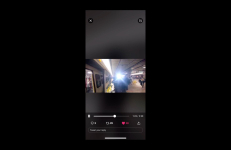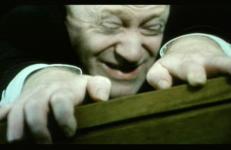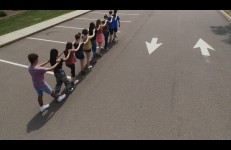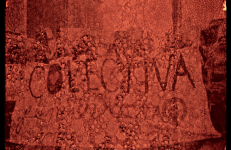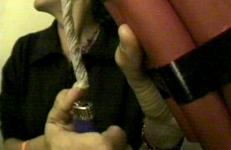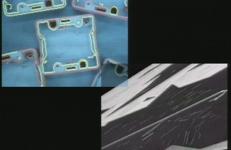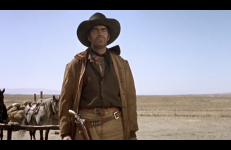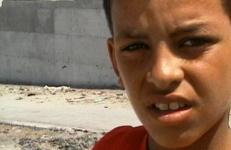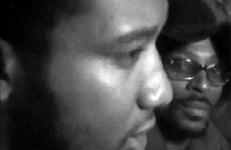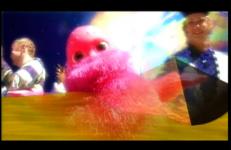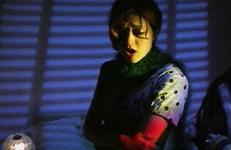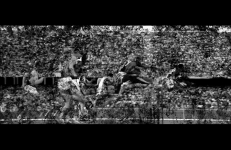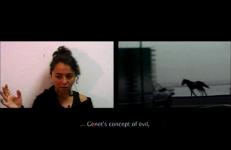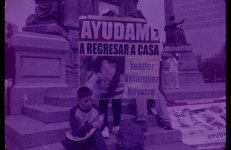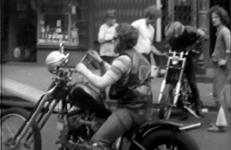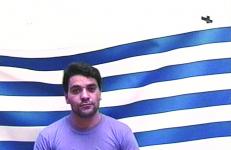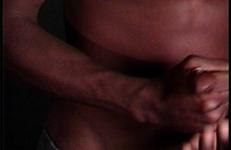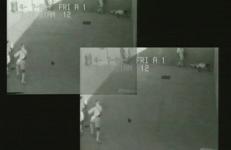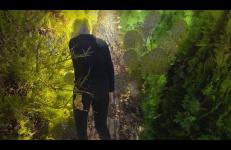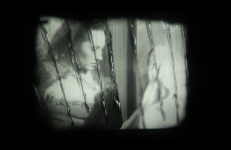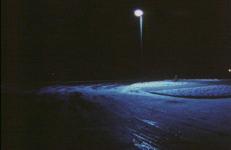Like a generation of viewers, I was profoundly affected by Deliverance. But I have always been troubled by the hegemonic structures of gender proposed by Boorman and Dickey. Hence, my version is played by women: myself, Peggy Ahwesh, Jackie Goss, Su Friedrich, and Meredith Root, all experimental filmmakers who work as academics. While faithful to our respective male characters, we also play ourselves.
Crime or Violence
Do Not Circulate, an experimental short film, attempts a structuralist and materialist approach to unraveling the entrails of a collective media memory. Paced by an essay as a relentless voiceover, the film rips footage that challenges the materiality, ownership and legal boundaries of documentation.
Imagine that the camera is possessed with a psychosis similar to human schizophrenia; suppose that this disease subtly changes every single frame of film while leaving the narrative superficially intact. Then imagine that these symptoms came on as a result of the trauma of recording bizarre or horrific events, for instance those of the 1941 horror film Dr Jekyll and Mr Hyde...
Adapted from the novel by Robert Louis Stevenson.
This title is also available on Paul Bush Pixilated.
Drills is a film about the choreography of preparing for the future. A hybrid documentary and experimental dance film reimagining the form of the Cold War-era, US government-produced social guidance film, Drills asks what futures we are preparing for through the exercises embodying present anxieties. Weaving in between multiple forms of choreography and documentation, Drills restages lockdown and active shooter drills, frames corporate and tech start-up office meditation, and reperforms Boy Scout drills from the 1917 Boy Scout manual.
In Dry Blood (Sagre Seca), various historical moments of political activism in Mexico are superimposed and corroded on the emulsion of expired film. Footage from the International Women's Day in 2017 is coupled with the recording of a powerful speech about the gruesome aftermath of the 2006 civil unrest in San Salvador Atenco.
An homage to Luis Bunuel's The Criminal Life of Archibaldo de la Cruz with a twist to these days control systems of security. From the moment we are suspects we are potential culprits. Therefore we are all guilty.
This title is also available on Half-Lies: The Videoworks of Ximena Cuevas.
In an empty room, a slideshow projection of abandoned places plays alongside the narrative of two girls who find themselves on the shores of a pre-apocalyptic paradise. Told through subtitle text that weaves fact and fiction together, the story of a massacre unfolds. When the image and text malfunctions and the story is no longer comprehensible, the video wanders away from the room of the slideshow, allowing us to see what is happening elsewhere.
"How can the distinction between "man" and "machine" still be made given today's technology? In modern weapons technology the categories are on the move: intelligence is no longer limited to humans. In Eye/Machine II, Farocki has brought together visual material from both military and civilian sectors, showing machines operating intelligently and what it is they see when working on the basis of image processing programs. The traditional man-machine distinction becomes reduced to "eye/machine", where cameras are implanted into the machines as eyes.
Found-footage video about America’s obsession with guns and some of the negative consequences of that obsession.
Forbidden to Wander chronicles the experiences of a 25-year-old Arab American woman traveling on her own in the occupied territories of the West Bank and Gaza Strip during the summer of 2002. The film is a reflection on the complexity of Palestinian existence and the torturously disturbing “ordinariness” of living under constant curfew. The film’s title reflects this, as the Arabic words used to describe the imposed curfew “mane’ tajawwul” literally translate as “forbidden to wander”.
The Videofreex conducted this interview with Fred Hampton, the Deputy Chairman of the Illinois chapter of the Black Panther Party, in October 1969, just over a month before he was killed by the Chicago police.
A sweeping saga of an evil matriarch and her march to infamy as she invades the hearts and souls of those organs and entities that reside in the male physique. A lustful excursion to the far corners of the globe as this vixen of vice weaves an occult web of sticky substances guaranteed to gummy up the gals and grease down the guys.
This crime drama made with my students at the San Francisco Art Institute is a mixed bag of colorful misadventures featuring a wayward member of the clergy and a corrupting, femme fatale with bangs. The couple open a casino of ill repute with money acquired during their murderous rampage upon the population of a small community of churchgoers. The action is fast and cheap because of the $400 budget, and the cast attractive because youth itself is always beautiful.
These are the ghosts of a haunted civilization, a culture of progress that hides the social and political horror behind the Olympic Games. These are the haunted figures in the Capitalocene era. A sinister dance of macabre abstraction. Part of the Hauntology series.
This video develops from a real event that took place during a theater seminar in the masters degree program at the University of Antioquia in Medellín, Columbia. The seminar occurred during one of the university's worst periods of violence. Two students in charge of a presentation on the life and work of French author Jean Genet decided to play a hoax on their fellow students - a hoax that involved an armed kidnapping. Their idea was to perform the ethos of Genet's work rather than to represent it in a conventional way.
Mother’s Day in Mexico is considered one of the most important family holidays of the year. Thousands of mothers have nothing to celebrate. They are the mothers of victims of forced disappearances. Mothers and relatives of the disappeared participated in the "March of National Dignity. Mothers searching for their Sons, Daughters and Justice."
In this tape, shot in August 1970, a number of Hells Angels are interviewed on the street in New York City. They talk about their bikes and their preparations for a “run”, and their reactions to the way they are portrayed by the mainstream media.
Home Movies Gaza introduces us to the Gaza Strip as a mircrocosm for the failure of civilization. In an attempt to describe the everyday of a place that struggles for the most basic of human rights, this video claims a perspective from within the domestic spaces of a territory that is complicated, derelict, and altogether impossible to separate from its political identity.
"... Basma Alsharif’s Home Movies Gaza, a film that captures the impossibly politicized domestic sphere of the Gaza Strip, under the constant hum and buzz of overhead drones."
Hostage: The Bachar Tapes (English Version) is an experimental documentary about "The Western Hostage Crisis." The crisis refers to the abduction and detention of Westerners like Terry Anderson, and Terry Waite in Lebanon in the 80s and early 90s by "Islamic militants." This episode directly and indirectly consumed Lebanese, U.S., French, and British political and public life, and precipitated a number of high-profile political scandals like the Iran-Contra affair in the U.S.
Hostage: The Bachar Tapes (English Version) is an experimental documentary about "The Western Hostage Crisis." The crisis refers to the abduction and detention of Westerners like Terry Anderson, and Terry Waite in Lebanon in the 80s and early 90s by "Islamic militants." This episode directly and indirectly consumed Lebanese, U.S., French, and British political and public life, and precipitated a number of high-profile political scandals like the Iran-Contra affair in the U.S.
A formidable collage of striking images, this powerful and provocative work confronts racial violence through images of ecological mayhem, machismo, pornography, and Third World poverty — images which return to the taboo body of a black man. "Directed and produced by our culture," An I for An I studies how violence is internalized and psychologized by overlapping soundtracks, printed texts, recurrent images, doctored footage and split screens. The piece attacks racist culture and pleads for an alternative recourse to violence.
“Images from the maximum-security prison in Corcoran, California. A surveillance camera shows a pie-shaped segment of the concrete yard where the prisoners, dressed in shorts and mostly shirtless, are allowed to spend half-an-hour a day. When one convict attacks another, those not involved lay flat on the ground, arms over their heads. They know that when a fight breaks out, the guard calls out a warning and then fires rubber bullets. If the fight continues, the guard shoots real bullets. The pictures are silent, the trail of gun smoke drifts across the picture.
I've Been Afraid is a musical encyclopedia about how women get abused, and why it is they stay. It uses emojis that are as ubiquitous as abuse is in our culture.
Music by Isaac Sherman
A woman raises her voice and gives a painful and endless speech that with time becomes even more overwhelming, because her words are heartbreaking and permanent impressions in the collective memory, stabbing with words an old Mexican film, a celluloid that tears apart until its disappearance.
This title is also available on the compilation What Was Always Yours and Never Lost.
An uncompromising look at the ways privacy, safety, convenience and surveillance determine our environment. Shot entirely at night, the film confronts the hermetic nature of white-collar communities, dissecting the fear behind contemporary suburban design. An isolation-based fear (protect us from people not like us). A fear of irregularity (eat at McDonalds, you know what to expect). A fear of thought (turn on the television). A fear of self (don’t stop moving).





